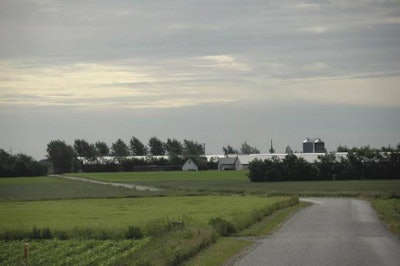
Feed prices may be dominating the thoughts of pig producers in Denmark as in other countries, but the Danes also have some longer-term issues to resolve. A major topic of concern throughout the country is whether the production of pigs will move abroad.
Although there is considerable Danish investment in pigmeat projects in other European countries, the point being debated here is more environmental. Fears abound that the constant dialogue over protecting the environment is diluting the political will to keep pork as Denmark's Number One meat business.
Members of a press contingent invited to tour Danish facilities earlier this year learned that Denmark would soon have strict new standards on the annual reduction of odours from pig units. Since January 2007, parliamentary legislation has already brought a clampdown on odour emissions relating to the proximity of the unit to residential areas. The lowest permitted concentration (measuring 5 on a scale of odour units per square metre) is for an enterprise sited close to an urban zone (see Figure 1 ). A limit of 7 on the same scale applies where there are more than 6 houses in the neighbourhood along with industrial and recreational areas. For instances in which an individual house is nearby in an otherwise rural district, the limit relaxes to 15.
Realise in this respect that the January law this year also introduced a requirement for all new, expanded or modified livestock farms with the equivalent of more than 75 animal units to have environmental approval covering not just odours, but also ammonia, nitrate and phosphorus emissions. It extends the net widely when compared with the former rules that made odour generation a factor only for the largest farms those with at least 250 animal units and for sites that were less than 30 metres from the nearest group of houses.
In certain areas, the difference between previous and current legislation is an increase of up to 32% in the number of sites affected.
The Danes acknowledge that the cheapest method for avoiding malodour problems is to locate production sites well away from the nearest neighbouring property, but they also know from their own research that such problems can be considerably reduced through appropriate adjustments to points including pen design, stocking density and ventilation. A guide sheet from the National Committee for Pig Production has noted that 70% of odour emissions from a breeding-finishing unit originate from the finisher section, that a partially slatted finishing facility emits about 30% less odour than one with all slats above a slurry pit, also that a grow-finish site releases 3-4 times more odour in summer than in a Danish winter.
Merete Lyngbye of Dansk Svinproduktion confirmed to the press delegation that odour remains the biggest air-related problem for pig units nationwide. She and colleague Anders Leegaard Riis set out a research agenda which prioritises the search to find ways of lessening odours from finishing sites. That must include ammonia, they explained. The expectation is that by the year 2015 there will be a 50% cut in the amount of nitrogen discharged per kilogram of pork produced, when compared with the level measured in 1985.
To put this in context, however, considerable strides in nitrogen (N) reduction have been made already. In 1985, Denmark measured 92 000 tons N in pig manure from a national production of 1.132 million tons of pork. By 2004 the nitrogen rating had risen to 104 000 tons, but at a time when 1.965 million tons of pigmeat were produced. In other words the N amount went up by only 13% while pork output was rising by 74%.
From remarks by University of Aarhus agricultural scientists Dr Niels Halberg and Randi Dalgaard, Danish pork has greatly diminished its environmental impact over the past 13 years through a combination of using a lower protein level in feeds, feeding less per kilogram of pig produced and being efficient at handling manure. Their comparison of data from Denmark with that of European neighbours gave the setting for a remark that the environmental profile of the Danes could be further improved. The adoption of anaerobic digestion technology to generate biogas from pig manure would certainly help, but the other possibilities emphasised were in productivity. By the year 2015, they indicated, Danish herds could achieve another 10% increase in pigs weaned per sow/year and a 10% reduction in the feed used per kilogram of pig.

















